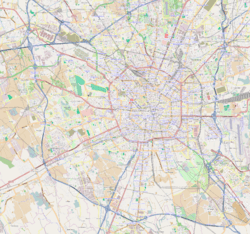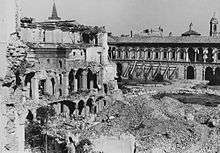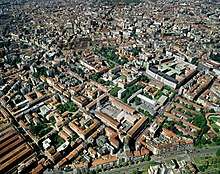Policlinico of Milan
| Policlinico of Milan | |
|---|---|
 | |
 Location within Milan | |
| General information | |
| Address | via Francesco Sforza, 28 |
| Town or city | [Milan] |
| Country | Italy |
| Coordinates | 45°27′36″N 9°11′33″E / 45.4600°N 9.1924°ECoordinates: 45°27′36″N 9°11′33″E / 45.4600°N 9.1924°E |
| Construction started | 1456 |
| Management | Marco Giachetti - Simona Giroldi - Fabio Agrò - Laura Chiappa - Silvano Bosari |
| Design and construction | |
| Architect | Antonio Filarete |
| Website | |
| www.policlinico.mi.it | |
The "Ca' Granda Ospedale Maggiore Policlinico" Foundation in Milan, traditionally known as the Policlinico of Milan, is one of the oldest hospitals in Italy, founded by Duke Francesco Sforza in 1456. Today it is a modern hospital with 900 beds, with wards for adults, pregnant women and children. There are three different emergency rooms for different categories of patients. The maternity ward (Mangiagalli Clinic) has the highest number of births in Lombardy.
The Foundation is a scientific Institute for Research, Hospitalization and Health Care (IRCCS), which means that, alongside clinical activity, it promotes research programs with predominantly translational purposes. The programs are concerned with the rapid transfer of therapies from the laboratory to patients.
Organization
- President: Marco Giachetti
- General Director: Simona Giroldi
- Administrative Director: Fabio Agrò
- Medical Director: Laura Chiappa
- Scientific Director: Silvano Bosari
History
In 1456 the Duke of Milan, Francesco Sforza, founded the Magna Domus Hospitalis (Ca' Granda), a hospital dedicated to Annunciata (a municipality of the province of Brescia, Northern Italy). He did so primarily to gain the affection of its people, who were followers of the Visconti family of Milan, even though the Duke was married to Bianca Maria Visconti at the time.


Entering Milan victorious on 25 March 1450 (the day of Annunciation), the Duke decided to dedicate a charitable institution to Annunciata. It was then that the new foundation became the Spedale della Nunciata. Designed by the renowned architect Filarete and built by the engineer Guiniforte Solari (responsible for the courtyard of the Certosa di Pavia, a monastery complex in Lombardy, Northern Italy), the hospital formed part of the completion of the reform of hospitals started by the Archbishop Rampini in the years of the Golden Ambrosian Republic.
The completion of the cloisters and their ornamentation was carried out by Giovanni Antonio Amadeo, Solari’s son-in-law and pupil. Although the hospital was founded for the poor, it was from the outset a hospital where people with some hope of recovery were treated. Chronic diseases were treated in hospitals outside the city. For this reason the Ospedale Maggiore has always been the centre of health information in the city.

At the beginning of the 20th century, it was decided that the hospital would be moved to a location beyond the canal (where work had already been started on its expansion). This move coincided with the founding of the state University, which took over the old buildings of the Ca' Granda, where it remains today. The Ospedale Maggiore moved to a vast area between the streets of Francesco Sforza (the site of the canal), Porta Romana, Lamarmora and Commenda.
The obstetrics and gynaecology department was the first to be inaugurated, by Luigi Mangiagalli (the first Chancellor of the University), and the department still bears his name.
At the time the hospital moved it had been decided that a general hospital would be created in the area of Niguarda (a neighbouring municipality, which had become part of Milan in 1923). This hospital was designed by Giò Ponti and inaugurated in 1932. It kept the name Ca' Granda, whilst the new general hospital took the name Ospedale Maggiore.

Further additions to the hospital institution included the San Carlo Borromeo di Milano (also designed by Giò Ponti) and the Sesto San Giovanni hospitals. The institution was later divided up, giving autonomy to the different institutes, whilst others were founded independently and included later.
In 1909 the Adelina brothers and Marco De Marchi founded the Asilo per le madri povere legittime "Regina Elena" (Regina Elena Refuge for Poor Mothers), which remained an independent service until 1990. In 1957 it was converted into a specialist hospital and in 1968 it became the Regina Elena Institute of Obstetrics-Gynaecology and Paediatrics. From 1998 to 2004 the clinical Institutes of Faithful Improvement, Mangiagalli and Regina Elena were placed under the same authority.
In 2010 the name of the hospital was changed, reverting to the former Ca' Granda.
Historical archive
Insignia and logo
The organisation’s insignia used to bear the scene of the Annunciation and the Latin motto 'ave gratiae plena' ("hail, full of grace"). Later it was simplified to a picture of the dove of the Holy Spirit.
The heraldic representation, still the basis of the Foundation’s current logo, is closely linked with the Visconti symbol of the flaming, radiant turtle-dove. The olive branch in the bird’s beak was added later. Until 1825 the Organisation had the duty of assisting children in need, who, considered as 'the hospital’s children', took the surname 'Colombo', meaning 'dove'.
The Niguarda, Sesto San Giovanni and San Carlo Borromeo hospitals also obtained insignias or sculptures reminiscent of the dedication.
Banner
The hospital has two banners of honour: one large banner, maintained in a museum collection, and a pair of smaller banners for use in ceremonies.
The need for a banner to display at ceremonies and funerals of benefactors arose in 1927, and inspiration was taken from the banner of the Municipality of Milan, which has particularly solemn connotations. The front of the banner represents the Annunciation. On the other side, the dove is embroidered, surrounded by the heraldic insignias of the hospital’s main benefactors: Sforza, Macchi, Del Sesto, Parravicini, Ponti, Secco Comneno, the municipality of Milano, Pio II Piccolomini, Pio IV Medici di Marignano, Pio XI Ratti, Cardinals Saint Carlo Borromeo e Schuster, and the Order of the Holy Sepulchre.
The project and its realisation were the responsibility of the Milanese architect Giò Ponti, who intended to add value to the banner using both materials and techniques. The metallic parts of the banner were created by the Ravasco firm, and Alfredo Ravasco, the company director, wanted to donate precious stones. Meanwhile, the Bartelli firm had completed the gold and silver embroidery on pure silk. The banner was inaugurated by Cardinal Ildefonso Schuster on 24 March 1935 (the first day of the Festival of Forgiveness) during a solemn function held in Milan’s Duomo.
In 1938 a copy was made, in order to be able to transport it with ease with just two poles. The original was moved to a collection in 1942 and decorated with crystals by the Silvestri firm.
Book of the Dead
At the beginning of the 19th century, the Milanese Carlo Ingnazio Busca brought a mummy in a sarcophagus and a papyrus to Milan. Today, the mummy can be found at Sforza Castle, while the papyrus is housed in the Historical Archive of the General Hospital. It is not open to public viewing, but is reproduced digitally with infra-red reflectography thanks to an agreement with the University of Milan’s Interdepartmental Centre of Infrared and Diagnostic Reflectography of Cultural Heritage, run by Professor Duilio Bertani.
The ancient Egyptian papyrus is called Libro per uscire dal giorno ("Book to leave the day") and reproduces the famous Book of the Dead, a series of formulae aimed to facilitate the soul on its last journey beyond the western horizon toward the afterlife. The scroll, almost seven metres long, was produced in Thebes for the scribe and designer Pthamose at the beginning of the nineteenth dynasty of Egypt (1305-1200 BC). It shows a complete text, full of drawings, and it mentions a series of formulae to activate several amulets, which is rare in similar papyri.
The heirs of the mummy had to decide what to do with this souvenir, and, taking advice from Dr. Pessani of the Ciceri-Agnesi Fatebenesorelle Hospital, they were persuaded to donate it to the Institute’s pharmacy (the mummy was in fact, at the time, considered to be a pharmacological remedy). The mummy then became part of the Civic Archaeological and Numismatic Collections at Sforza Castle.
Departments
The Ospedale Maggiore General Hospital- Mangiagalli- Regina Elena Foundation, has two executive committees which are divided into separate departments.
Ospedale Maggiore General Hospital Committee
- Zonda Department: general surgery and transplants
- Monteggia Department: surgery (head and neck)
- Sacco Department: radiology, cardiology, lungs
- Granelli-Marcora Department: internal medicine, gastroenterology, endocrinology, haematology
- Litta Department: the first to be built in the area beyond the Canal in 1895; it houses the Association of Italian Rescue Workers
- Frigerio Department (Lamarmora) group practice
- Beretta Neuro Department: brainsurgery
- Ponti Department: neurology
- Guardia Department: A&E
- Guardia II Department:psychiatry
- Marangoni Department: immunohaematology, transfusions and transplants
References
